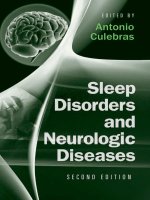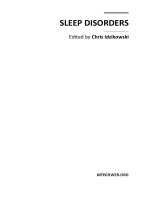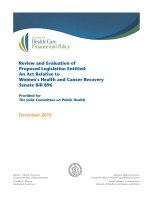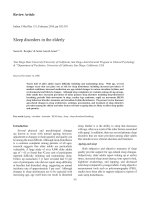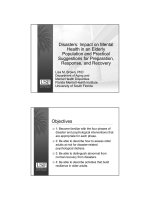07 passive recovery sleep
Bạn đang xem bản rút gọn của tài liệu. Xem và tải ngay bản đầy đủ của tài liệu tại đây (596 KB, 19 trang )
UNIVERSITY
Passive
Recovery:
Sleep
How to Improve Sleep For
Recovery
Lesson Overview
• What is sleep and why we need it
• Effects of sleep deprivation on performance
• How to Improve Sleep
What is Sleep?
The physiological process where metabolic and other regulatory
functions halt for a period of time so that the body systems recover
and prepare the next day’s functional needs (1).
Sleep Stages (90-120 minute cycles) 4-6x per night
• Rapid Eye Movement (REM): dream and memory consolidation
• Slow Wave (nonREM): Slowing of body function, most restful sleep
Sleep Mechanisms: regulate awake and sleep
• Circadian (biological clock) rhythm: Based on 24-hour day, controls
sleep, hormone release, body temperature.
• Sleep-wake homeostasis: Tracks need for sleep. Influenced by stress,
nutrition, exercise, medications.
What Does it Do?
• Restore Immunological and endocrine balance
• Increase parasympathetic activity
• Recovery of nervous system and metabolic systems
• Enhance memory consolidation and learning
• Growth hormone release and Tissue repair
Effects of Sleep Deprivation
Sleep Deprivation
•
•
•
•
•
•
•
•
•
•
Altered glycemic control and decreased insulin sensitivity (4)
Decreased Leptin and Increased Ghrelin (1)
Reduced Oxygen Consumption and Cardiovascular Performance
Reduced Motor Learning and Control
Reduced Growth Hormone and Testosterone Levels
Lower Lymphocyte and antibody levels
Decreased mood, motivation, perception of fatigue
Increase in Recurrent Injuries and slowed injury repair
Highly Associated with overtraining
5 nights of 50% sleep reduction decrease muscle protein synthesis
(2)
• During caloric restriction, sleep loss increased muscle loss and
decreased fat loss (3)
• CONTEST PREP:
Muscle Fat
• OFFSEASON: Muscle
Fat
Optimal Sleep Durations
•
•
•
•
Recreational Athletes: 7-8 hours per night
Advanced Athletes: 8-10 hours per night
Sleep and mortality relation is a U-shaped curve
Too much sleep can result in increased drowsiness and fatigue and
increased association of all cause mortality and CVD (5).
• Too little sleep <7-8 hours related to increased mortality risk and
CVD, DM,HTN. For every 1 hour decrease there is a 6% increase in
risk (5).
• Sleep needs vary based on person and needs at current day
Sleep Extension and Naps (6)
Sleep Extension
• Allotting more time for sleep and bedtime in general most
efficacious for improved performance
• Time management strategies for sleep opportunities
Naps
IF under slept any nap duration is better than none
30+ minute naps can improve physical performance
45 minute for cognitive performance
Nap in morning or early afternoon
Catch up Sleep
Sleep deprivation and Catch up Sleep on weekend in a caloric deficit
lead to great muscle loss and less fat loss.
Sleep Hygiene
•
•
•
•
Routine Bedtime
Dimly light and cool environment
White noise or ear plugs
Limit Blue Light
•
•
•
•
Hot bath prior to bedtime
Remove distractions from bedroom and clutter
Relaxing activities prior to bedtime
Journal down thoughts and worries
• Decrease technology use at night-time
• Blue Light Blockers
Training Around Sleep (7)
• Limit caffeinated pre workout
• Exercise in evening has a slight positive effect
• Vigorous exercise < 1-hour prior to sleep can be impaired increased
HR and blunted parasympathetic activity
• Meal timing factored in, limit large meals 2 hours prior to bedtime
Nutrition Around Sleep (8)
• Protein
• BCAA/TRP
• Grehlin
• Casein Shake?
• Dietary Fat
• Saturated fats positive effect
• Unsaturated fats potential negative effect on melatonin
• High calorie/fat intake disruptive
• Carbohydrates
• uptake of BCAA but not TRP into muscle
• Chrononutrition
•
•
•
•
•
Gastric emptying rate higher in AM
Higher beta cell function in AM
Greater glucose excursion in evening
Increased TEF in AM vs PM
Smaller feeding window based on day/night cycle
Sleep Apnea
Repetitive episodes of complete or partial upper airway obstruction during sleep
• HTN, CVD, DM
• 27% profession football players and 37% rugby/cricket players
Risk Factors:
• Snoring
• Apneas
• Daytime Sleepiness/fatigue
• Morning Headaches
• Hx HTN
Physical Factors
• Obesity
• Lange Neck circumference
• Male
• Crowded oropharynx
Diagnostic
• Home or in lab sleep test
Treatment
• Continuous Positive Airway Pressure (CPAP)
Sleep Mechanics (9)
• Side lying decreased association with cervical and spinal symptoms
• Pillow between legs
• Supine sleep
• Elevate legs for lower back discomfort
• Limit Prone sleeping
• Invest is quality mattress firmness is a preference
• Invest in quality pillow (ie Envy pillow)
Harmful Sleep Items
• Limit Caffeine 6-9 hours prior to sleep
• Limit alcohol 4 hours prior to sleep
• THC and CBD
• “Taken together, research suggests that short-term use of cannabis may
have a therapeutic impact on sleep, specifically related to sleep onset
latency and slow wave sleep. However, long-term chronic use is associated
with habituation to the sleep-enhancing benefits and is associated with increased risk for cannabis dependence” Babson 2017
Anabolic Steroids, Aromatase Inhibitors and SERMS
• Night Sweats and Estrogen
• Hypothalamus dysregulation and body temp control
• Upregulation of hypocretin/orexin (Hcrt) with Trenbolone
• Other Sedatives
Sleep Tracking
• Fitbit
• Oura Ring
• Journal
Shift Workers
Day of nightshift
• Sleep in as long as possible
Resetting after night shift
• 2 hours nap after shift
• Avoid caffeine
• Nap in afternoon
• Get outdoors
• Bedtime back to normal
During night shift
• Stay active
• Caffeine early on allowed
Adjusting Nutrition
• Continue protein bolus feedings 3-5
hours
• 10-20 minute nap if able
• Limit light exposure on way home
and use blue light blockers
Between night shift
• Avoid lights, darken your room
• Fragmented sleep better than no
sleep
• Got to sleep early as possible
• Previous nutrition guidelines are the
same
Adjusting Training
• Limit training in high fatigue state,
program light sessions
Helpful Sleep Aids
• Circadian Day/Night Regulation:
• Melatonin 1-3mg 30minutes prior to bedtime
• Relaxation:
• L-theanine 200mg (non sedative)
• Valerian 450mg
• Lemon Balm 300mg
• Vitamin Deficiencies to correct
• Magnesium
• Zinc
• Vitamin D
Practical Recommendations
1.
2.
3.
4.
5.
6.
7.
8.
9.
10.
11.
12.
13.
14.
15.
16.
17.
Keep a regular sleep/wake cycle
Daylight exposure early in the day
Nap early day to make up lost sleep
Limit caffeine 7 hours prior and alcohol 4 hours prior to sleep
Avoid large meals 2 hours prior to sleep, favor carbohydrates
Taper Fluids in the evenings
Journal any busy thoughts and have a wind down process
Shut down electronics, reduce blue ray exposure prior to sleep
Aim for 8-9 hours of in bedtime
Hot shower prior to bedtime
Set alarm for bedtime
Keep room dark and cool
Address sleep apnea and snoring
Invest in a quality mattress and pillow
If wake up and get sleep go out of bedroom and do a relaxing activity
Proper hormone balance, monitor side effects and lab work
Utilize dietary supplements as an aid
References
1.
2.
3.
4.
5.
6.
7.
8.
9.
10.
11.
Chandrasekaran, Baskaran & Fernandes, S. & Davis, Fiddy. (2019). Science of sleep and sports
performance – a scoping review. Science & Sports. 10.1016/j.scispo.2019.03.006.
Saner NJ, Lee MJ, Pitchford NW, et al. The effect of sleep restriction, with or without high-intensity
interval exercise, on myofibrillar protein synthesis in healthy young men. J Physiol. 2020;598(8):15231536. doi:10.1113/JP278828
Nedeltcheva AV, Kilkus JM, Imperial J, Schoeller DA, Penev PD. Insufficient sleep undermines dietary
efforts to reduce adiposity. Ann Intern Med. 2010;153(7):435-441. doi:10.7326/0003-4819-153-7201010050-00006
Beccuti G, Pannain S. Sleep and obesity. Curr Opin Clin Nutr Metab Care. 2011;14(4):402-412.
doi:10.1097/MCO.0b013e3283479109
Yin J, Jin X, Shan Z, et al. Relationship of Sleep Duration With All-Cause Mortality and Cardiovascular
Events: A Systematic Review and Dose-Response Meta-Analysis of Prospective Cohort Studies. J Am
Heart Assoc. 2017;6(9):e005947. Published 2017 Sep 9. doi:10.1161/JAHA.117.005947
Bonnar D, Bartel K, Kakoschke N, Lang C. Sleep Interventions Designed to Improve Athletic Performance
and Recovery: A Systematic Review of Current Approaches. Sports Med. 2018;48(3):683-703.
doi:10.1007/s40279-017-0832-x
Stutz J, Eiholzer R, Spengler CM. Effects of Evening Exercise on Sleep in Healthy Participants: A
Systematic Review and Meta-Analysis. Sports Med. 2019;49(2):269-287. doi:10.1007/s40279-018-10150
Malhotra RK. Sleep, Recovery, and Performance in Sports. Neurol Clin. 2017;35(3):547-557.
doi:10.1016/j.ncl.2017.03.002
Cary D, Briffa K, McKenna L. Identifying relationships between sleep posture and non-specific spinal
symptoms in adults: A scoping review. BMJ Open. 2019;9(6):e027633. Published 2019 Jun 28.
doi:10.1136/bmjopen-2018-027633
Babson KA, Sottile J, Morabito D. Cannabis, Cannabinoids, and Sleep: a Review of the Literature. Curr
Psychiatry Rep. 2017;19(4):23. doi:10.1007/s11920-017-0775-9
Mi P, Gao Q, Feng ZY, et al. Melatonin attenuates 17β-trenbolone induced insomnia-like phenotype and
movement deficiency in zebrafish. Chemosphere. 2020;253:126762.
doi:10.1016/j.chemosphere.2020.126762



